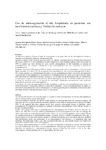Mostrar o rexistro simple do ítem
Uso de anticoagulación al alta hospitalaria en pacientes con insuficiencia cardíaca y fibrilación auricular
| dc.contributor.author | Mosquera Pérez, Ignacio | |
| dc.contributor.author | Muñiz, Javier | |
| dc.contributor.author | Freire Castroseiros, Evaristo | |
| dc.contributor.author | García Castelo, Alberto | |
| dc.contributor.author | Castro-Beiras, Alfonso | |
| dc.date.accessioned | 2015-10-20T08:38:57Z | |
| dc.date.available | 2015-10-20T08:38:57Z | |
| dc.date.issued | 2003 | |
| dc.identifier.citation | Mosquera Pérez I, Muñiz García J, Freire Castroseiros E, García Castelo A, Castro-Beiras A. Uso de anticoagulación al alta hospitalaria en pacientes con insuficiencia cardíaca y fibrilación auricular. Rev Esp Cardiol.2003;56(9):880-887 | es_ES |
| dc.identifier.uri | http://hdl.handle.net/2183/15387 | |
| dc.description.abstract | [Resumen] Introducción y objetivos. Evaluar el grado de cumplimiento de las guías sobre uso de anticoagulación crónica en pacientes con insuficiencia cardíaca y fibrilación auricular. Pacientes y método. Se usó la base de datos del estudio INCARGAL, analizando datos de 195 pacientes consecutivos (88 varones, edad 76 ± 10 años) admitidos con ambos diagnósticos en tres hospitales gallegos entre enero y junio de 1999. Se asumió que todos deberían de haber recibido anticoagulación al alta hospitalaria en ausencia de contraindicaciones. Se comparó el tratamiento al alta (anticoagulación o no) con la presencia o ausencia de contraindicaciones. Resultados. Un total de 152 pacientes (78%) no tenían contraindicaciones para la anticoagulación y 43 presentaban alguna (absoluta, 11; relativa, 32). De los pacientes sin contraindicación, sólo recibieron anticoagulación al alta el 50%. Ningún paciente con contraindicación absoluta y tres con contraindicación relativa recibieron anticoagulación. La prescripción de anticoagulación en los pacientes sin contraindicaciones fue menor en los que tenían una mayor edad, antecedente de cardiopatía isquémica, ausencia de valvulopatía, uso de bloqueadores beta, no realización de ecocardiograma e ingreso en un servicio diferente del de cardiología (p < 0,05). En el análisis multivariante, la edad, el infarto de miocardio previo y la ausencia de valvulopatía significativa permanecieron como predictores independientes de menor uso de anticoagulación. Conclusiones. El empleo de anticoagulación al alta hospitalaria en pacientes sin contraindicación para su uso, con fibrilación auricular e insuficiencia cardíaca, es menor del recomendado. La edad avanzada disminuye su empleo. La presencia de otras indicaciones para la antiagregación o la anticoagulación parecen determinar la elección de una u otra terapia. No hubo mala adecuación por exceso de prescripción. | es_ES |
| dc.description.abstract | [Abstract] Introduction and objectives. To assess the degree of compliance with current guidelines for chronic anticoagulation in patients with heart failure and atrial fibrillation. Patients and method. From the INCARGAL Study database, we analyzed data from 195 consecutive patients (88 men; mean age 76 ± 10 years) with both conditions, admitted to three Galician hospitals between January and March 1999. It was assumed that these patients should have received anticoagulant therapy at discharge, unless contraindicated. We studied the association of treatment at discharge (anticoagulation or not) with the presence or absence of contraindications. Results. -152 patients (78%) had no contraindication for anticoagulation and 43 had at least one (absolute: 11, relative: 32). Only 50% of patients without contraindications received anticoagulation at the time of discharge. No patient with an absolute contraindication and 3 with a relative one received anticoagulation. Factors related with the less frequent prescription of anticoagulation therapy in patients without a formal contraindication were: age, a previous history of coronary heart disease, absence of valvular heart disease, prior' myocardial infarction, treatment with beta-blocking agents, non performance of an echocardiogram, and admission to a department other than cardiology. On multivariate analysis, age, prior myocardial infarction, and non-valvular disease were found to be independent predictors of less use of anticoagulation. Conclusions. Anticoagulant therapy is used less often than recommended at discharge in patients with heart failure and atrial fibrillation for whom there were no contraindications. Advanced age reduces its use. The presence of other indications for antiplatelet or anticoagulatión therapy appears to determine the choice of one or the other. Noncompliance with the guidelines due to overprescription was not found. | es_ES |
| dc.language.iso | spa | es_ES |
| dc.publisher | Elsevier | es_ES |
| dc.relation.uri | http://dx.doi.org/10.1016/S0300-8932(03)76976-0 | es_ES |
| dc.rights | Creative Commons Licence | es_ES |
| dc.rights | Reconocimiento-NoComercial-SinObraDerivada 4.0 Internacional | |
| dc.rights.uri | http://creativecommons.org/licenses/by-nc-nd/4.0/ | |
| dc.subject | Anticoagulantes | es_ES |
| dc.subject | Fibrilación auricular | es_ES |
| dc.subject | Insuficiencia cardiaca | es_ES |
| dc.subject | Anticoagulants | es_ES |
| dc.subject | Atrial fibrillation | es_ES |
| dc.subject | Heart failure | es_ES |
| dc.title | Uso de anticoagulación al alta hospitalaria en pacientes con insuficiencia cardíaca y fibrilación auricular | es_ES |
| dc.title.alternative | Use of anticoagulation at the time of discharge in patients with heart failure and atrial fibrillation | es_ES |
| dc.type | info:eu-repo/semantics/article | es_ES |
| dc.rights.access | info:eu-repo/semantics/openAccess | es_ES |
Ficheiros no ítem
Este ítem aparece na(s) seguinte(s) colección(s)
-
GI- GRINCAR - Artigos [226]






